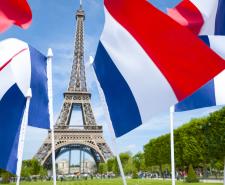
Read more about Modern History

Apart from the Catholic holy day of La Toussaint (better known to non-French speakers as ‘All Saint’s Day) on 1st November, Bastille Day is the most important date in the French calendar.
It's been celebrated annually since 14th July 1880 to commemorate the fall of the Bastille in Paris. But why did the storming of an old fort in 1789 have such a huge impact on the national psyche?
To answer that we need to go back to the former French political and social system known as ‘ancien régime’ (‘old order’) which we would recognise today as Feudalism.
The easiest way to describe Feudalism is to jump back to the English Middle Ages, roughly the 9th to the 15th century, to examine a hierarchical system of order that was widespread across Europe. In essence, it involves the king giving political power to the clergy and land to the nobles or lords. In turn, the nobles gave land to the vassals or knights, who then gave land to the peasants or serfs.
In return, the peasants provided the vassals and knights with food and labour, the vassals and knights protected the nobles and lords, and the nobles and lords answered to the king, who was further empowered with divine rights courtesy of his clergy.
Unsurprisingly, the Black Death that swept across England in the 14th century had the biggest impact on the lower classes. It decimated the bottom tier of society, those that toiled in the fields, which led to a wage increase to encourage the remaining population to work. But when Parliament enacted the Statute of Laborers, forcing the poor to work on a minimum wage, it led to the Peasants Revolt in 1381.
The revolution ended the enforced regulation of peasants’ wages which gave the lower orders greater spending power, so it was only a matter of time before the manorial system (where nobles would provide land to peasants in return for a substantial portion of the harvest) collapsed. By the time Queen Elizabeth I ascended to the throne in 1558, Feudalism in England was all but dead. But in France, it wasn’t.
It was a culmination of factors such as a reduced mortality rate alongside a general improvement in the standard of living and education. This led to a new middle class in the form of the French bourgeoise, all of whom paid taxes that the nobility and clergy didn’t.
Inspired by their impoverished English counterparts having emancipated themselves from the misery of Feudalism, and the success of the American Revolution, it was time for the citizens of France to free themselves from King Louis XVI's crushing absolutism which allowed him, his wealthy nobles and prosperous clergy, to do pretty much as they pleased.
Originally, the Bastille Saint-Antoine was a medieval fortress built to protect Paris from the English, but by the 17th century, under the stewardship of the loathed Cardinale de Richelieu, it was being used as a Parisian state prison. Louis XVI used it to incarcerate political troublemakers and store prohibited literature, inadvertently turning the now despised Bastille into a symbolic expression of authoritarianism and oppression.
On 14th July 1789, it was invaded by the first wave of revolutionaries and, after some fighting that saw the prison governor’s head being paraded on the end of a spike, the prisoners were freed, and the Bastille emblematically razed to the ground.
Quite simply, the French Revolution. In the following 11 bloody years, which witnessed the public execution of Louis XVI and his adherents, the revolutionaries helped overthrow the old order and establish a new system. Ultimately Napoleon Bonaparte appointed himself France’s ‘first consul’ and a proud French Republic stood under the new tricolour flag representing 'Liberté, Egalité, Fraternité' (‘liberty, equality and fraternity’).
14th July is a public holiday, so the parties begin in earnest the evening before. These are usually lively affairs involving food, drink and fireworks in readiness for the main event. Unsurprisingly, Paris takes centre stage in the Bastille Day celebrations with Europe’s oldest and largest military parade taking place on the Champs-Elysées in the morning.
Later in the day, crowds congregate around the Trocadéro ponds and the Eiffel Tower to enjoy a spectacular firework display. Over 2,000 fireworks are ignited during an event that lasts for 30 minutes.
A later addition to the festivities is the Fireman’s Ball, a tradition that was established in Montmartre when, in 1937, the local fire station opened its doors to Bastille revellers. Now fire stations all over France are open for parties on Bastille Day!
Originally, la Fête Nationale was set up on 14th July 1790 to commemorate the ‘Fête de la Fédération’ when 100,000 Parisian gathered to celebrate the new French Republic at the Champs de Mars. But the symbolic association with the storming of the Bastille has prevailed.
Unsurprisingly it’s celebrated in French Polynesia and Liège in Belgium, but it’s also a big event in the US, enjoyed in about 20 states. It’s also a big deal in Budapest, but the most obscure Bastille Day location is in Pondicherry, a former French colony in India.
The French wouldn’t recognise ‘Bastille Day’ as a thing. So, don’t say ‘Happy Bastille Day’ when you’re in France. Go for ‘Bonne Fête Nationale’ or ‘Joyeux Quatorze Juillet’ and you’ll be just fine.